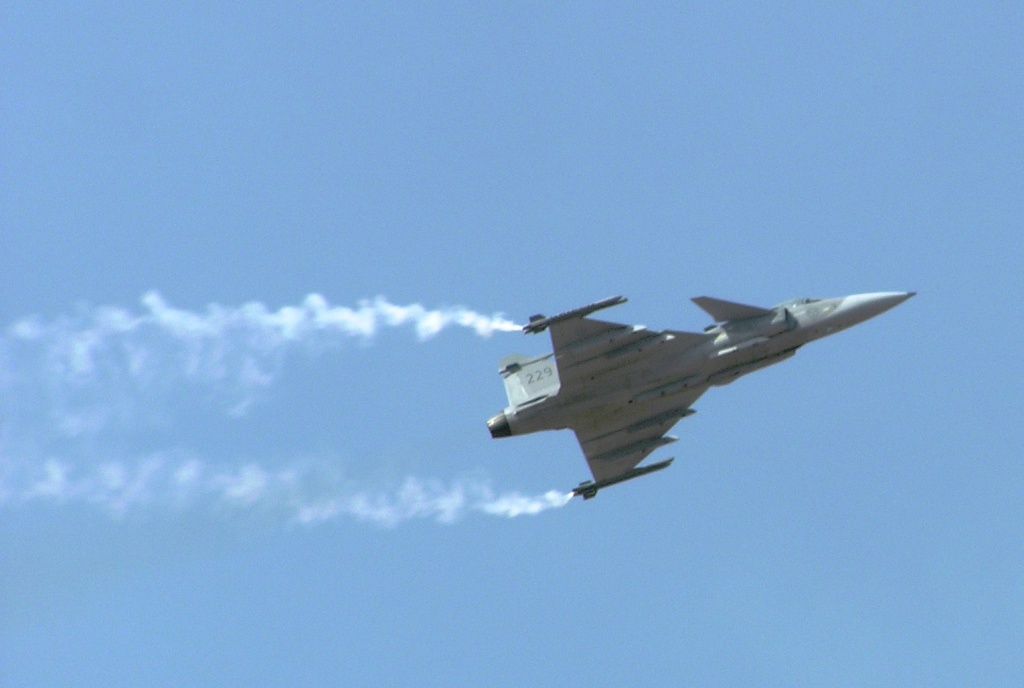MiG-29
Banned Idiot
Re: J-20... The New Generation Fighter III
Let us see if the Russians agree with you
При нестационарном обтекании нарушается боковая балансировка самолета и возникает опасность его сваливания на крыло с последующим переходом в штопор
due to turbulent flow, the aircraft experiences lateral instability and the risk of stall and depart into flat spins
Однако инертность истребителя, небольшая продолжительность "Кобры" (около 10 секунд) и упреждающие действия летчика рулями позволяют избежать этого.
However, the short duration of "Cobra" (about 10 seconds) and the anticipated application of the tailplaness allows the pilot to avoid all that .
Тем не менее, выполнение "Кобры" показало принципиальную возможность удержать самолет от сваливания на закритических углах атаки
however the excecution of the cobra has shown the basic ability to keep the aircraft from stalling at supercritical angles of attack.
рулями=tailplanes

obviously the Gripen is trying to pull down the nose its deflection is negative hahahaha
but the MiG-29 is not flying with a horizontal velocity vector niether a vertical velocity vector but rather diagonal vector gaining altitide and with the tail pitching up thus
"Angle of Attack and tailplane deflection depend very strongly on the flight path angle in the post stall region, and practically do not depend in the below stall region "
ah i see the MiG like the Su do deflect the tailplane according to the flight path gamma angle (velocity vector) and Alpha angle (angle with respect the Gamma angle) ah i see
minute 1:13 mig deploys tailplanes at 110 degrees of AoA haha
[video=youtube;RJ_ds1SgBG0]http://www.youtube.com/watch?v=RJ_ds1SgBG0&feature=player_embedded[/video]
.
As far as debunking your claim goes, we have went through this already. The cause for crash of the aircraft was pilot error, said so in your own quote:
The picture shows the tailplane rotated downward, which isn't going to generate any pitch-down moment even if the aircraft were not flying at high AoA.
Let us see if the Russians agree with you
При нестационарном обтекании нарушается боковая балансировка самолета и возникает опасность его сваливания на крыло с последующим переходом в штопор
due to turbulent flow, the aircraft experiences lateral instability and the risk of stall and depart into flat spins
Однако инертность истребителя, небольшая продолжительность "Кобры" (около 10 секунд) и упреждающие действия летчика рулями позволяют избежать этого.
However, the short duration of "Cobra" (about 10 seconds) and the anticipated application of the tailplaness allows the pilot to avoid all that .
Тем не менее, выполнение "Кобры" показало принципиальную возможность удержать самолет от сваливания на закритических углах атаки
however the excecution of the cobra has shown the basic ability to keep the aircraft from stalling at supercritical angles of attack.
рулями=tailplanes

obviously the Gripen is trying to pull down the nose its deflection is negative hahahaha
but the MiG-29 is not flying with a horizontal velocity vector niether a vertical velocity vector but rather diagonal vector gaining altitide and with the tail pitching up thus
"Angle of Attack and tailplane deflection depend very strongly on the flight path angle in the post stall region, and practically do not depend in the below stall region "
ah i see the MiG like the Su do deflect the tailplane according to the flight path gamma angle (velocity vector) and Alpha angle (angle with respect the Gamma angle) ah i see
minute 1:13 mig deploys tailplanes at 110 degrees of AoA haha
[video=youtube;RJ_ds1SgBG0]http://www.youtube.com/watch?v=RJ_ds1SgBG0&feature=player_embedded[/video]
Last edited:
